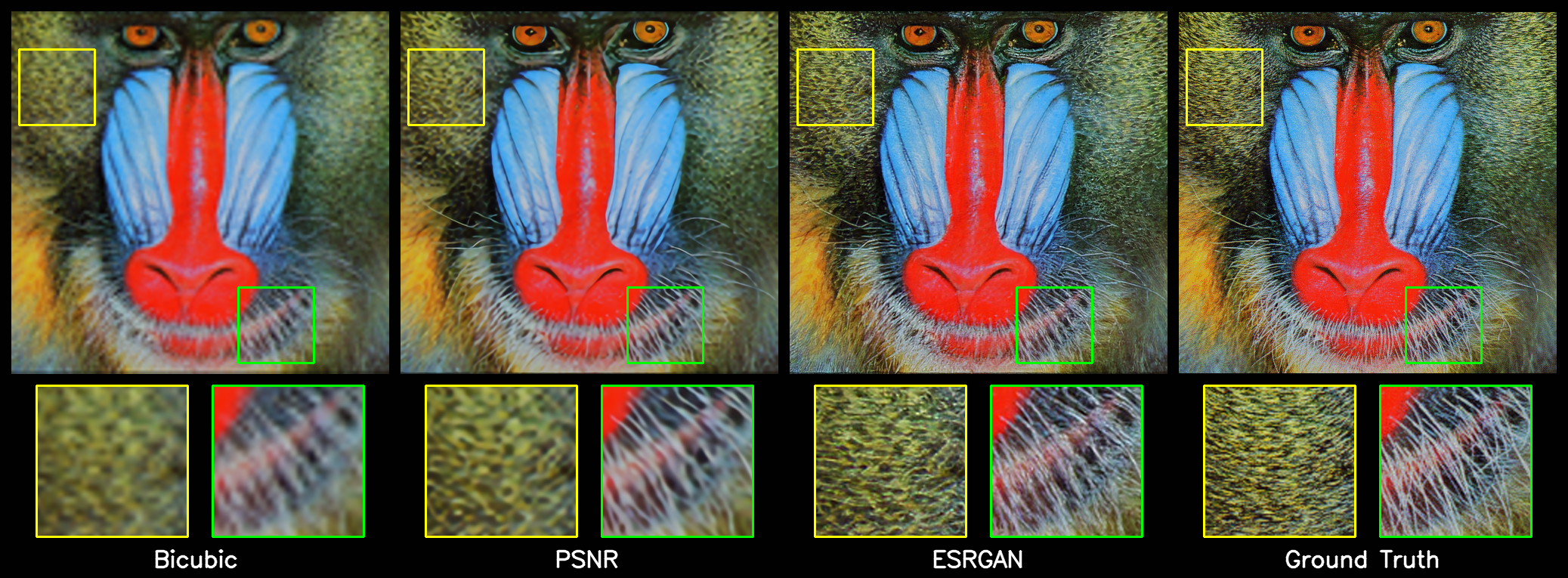🔥 ESRGAN (Enhanced Super-Resolution Generative Adversarial Networks, published in ECCV 2018) implemented in Tensorflow 2.0+. This is an unofficial implementation. 🔥
ESRGAN introduce the Residual-in-Residual Dense Block (RRDB) without batch normalization as the basic network building unit, the idea from relativistic GAN to let the discriminator predict relative realness, and the perceptual loss by using the features before activation. Benefiting from these improvements, the proposed ESRGAN achieves consistently better visual quality with more realistic and natural textures than SRGAN and won the first place in the PIRM2018-SR Challenge.
Original Paper: Arxiv ECCV2018
Offical Implementation: PyTorch
:: Results from this reporepository. ::

📑
🍕
Create a new python virtual environment by Anaconda or just use pip in your python environment and then clone this repository as following.
git clone https://github.com/peteryuX/esrgan-tf2.git
cd esrgan-tf2conda env create -f environment.yml
conda activate esrgan-tf2pip install -r requirements.txt🍺
All datasets used in this repository follow the official implement as same as possible. This code focus on implementation of x4 version.
Step 1: Download the DIV2K GT images and corresponding LR images from the download links bellow.
| Dataset Name | Link |
|---|---|
| Ground-Truth | DIV2K_train_HR |
| LRx4 (MATLAB bicubic) | DIV2K_train_LR_bicubic_X4 |
Note: If you want to dowsample your traning data as LR images by yourself, you can use the imresize_np() wich is numpy implementation or MATLAB resize.
Step 2: Extract them into ./data/DIV2K/. The directory structure should be like bellow.
./data/DIV2K/
-> DIV2K_valid_HR/
-> 0001.png
-> 0002.png
-> ...
-> DIV2K_train_LR_bicubic/
-> X4/
-> 0001x4.png
-> 0002x4.png
Step 3: Rename and Crop to sub-images with the script bellow. Modify these scripts if you need other setting.
# rename image file in LR folder `DIV2K_train_LR_bicubic/*'.
python data/rename.py
# extract sub-images from HR folder and LR folder.
python data/extract_subimages.pyStep 4: Convert the sub-images to tfrecord file with the the script bellow.
# Binary Image (recommend): convert slow, but loading faster when traning.
python data/convert_train_tfrecord.py --output_path="./data/DIV2K800_sub_bin.tfrecord" --is_binary=True
# or
# Online Image Loading: convert fast, but loading slower when training.
python data/convert_train_tfrecord.py --output_path="./data/DIV2K800_sub.tfrecord" --is_binary=FalseNote:
- You can run
python ./dataset_checker.pyto check if the dataloader work.
Step 1: Download the common image SR datasets from the download links bellow. You only need Set5 and Set14 in the default setting ./configs/*.yaml.
| Dataset Name | Short Description | Link |
|---|---|---|
| Set5 | Set5 test dataset | Google Drive |
| Set14 | Set14 test dataset | Google Drive |
| BSDS100 | A subset (test) of BSD500 for testing | Google Drive |
| Urban100 | 100 building images for testing (regular structures) | Google Drive |
| Manga109 | 109 images of Japanese manga for testing | Google Drive |
| Historical | 10 gray LR images without the ground-truth | Google Drive |
Step 2: Extract them into ./data/. The directory structure should be like bellow. The directory structure should be like bellow.
./data/
-> Set5/
-> baby.png
-> bird.png
-> ...
-> Set14/
-> ...
🍭
You can modify your own dataset path or other settings of model in ./configs/*.yaml for training and testing, which like below.
# general setting
batch_size: 16
input_size: 32
gt_size: 128
ch_size: 3
scale: 4
sub_name: 'esrgan'
pretrain_name: 'psnr_pretrain'
# generator setting
network_G:
nf: 64
nb: 23
# discriminator setting
network_D:
nf: 64
# dataset setting
train_dataset:
path: './data/DIV2K800_sub_bin.tfrecord'
num_samples: 32208
using_bin: True
using_flip: True
using_rot: True
test_dataset:
set5_path: './data/Set5'
set14_path: './data/Set14'
# training setting
niter: 400000
lr_G: !!float 1e-4
lr_D: !!float 1e-4
lr_steps: [50000, 100000, 200000, 300000]
lr_rate: 0.5
adam_beta1_G: 0.9
adam_beta2_G: 0.99
adam_beta1_D: 0.9
adam_beta2_D: 0.99
w_pixel: !!float 1e-2
pixel_criterion: l1
w_feature: 1.0
feature_criterion: l1
w_gan: !!float 5e-3
gan_type: ragan # gan | ragan
save_steps: 5000Note:
- The
sub_nameis the name of outputs directory used in checkpoints and logs folder. (make sure of setting it unique to other models) - The
using_binis used to choose the type of training data, which should be according to the data type you created in the Data-Preparing. - The
w_pixel/w_feature/w_ganis the combined weight of pixel/feature/gan loss. - The
save_stepsis the number interval steps of saving checkpoint file.
Pretrain the PSNR RDDB model by yourself, or dowload it from BenchmarkModels.
python train_psnr.py --cfg_path="./configs/psnr.yaml" --gpu=0Train the ESRGAN model with the pretrain PSNR model.
python train_esrgan.py --cfg_path="./configs/esrgan.yaml" --gpu=0Note:
- Make sure you have the pretrain PSNR model before train ESRGAN model. (Pretrain model checkpoint should be located at
./checkpointsfor restoring) - The
--gpuis used to choose the id of your avaliable GPU devices withCUDA_VISIBLE_DEVICESsystem varaible. - You can visualize the learning rate scheduling by running "
python ./modules/lr_scheduler.py".
You can download my trained models for testing from Models without training it yourself. And, evaluate the models you got with the corresponding cfg file on the testing dataset. The visualizations results would be saved into ./results/.
# Test ESRGAN model
python test.py --cfg_path="./configs/esrgan.yaml"
# or
# PSNR pretrain model
python test.py --cfg_path="./configs/psnr.yaml"You can upsample your image by the SR model. For example, upsample the image from ./data/baboon.png as following.
python test.py --cfg_path="./configs/esrgan.yaml" --img_path="./data/baboon.png"
# or
# PSNR pretrain model
python test.py --cfg_path="./configs/psnr.yaml" --img_path="./data/baboon.png"Produce the compare results between network interpolation and image interpolation as same as original paper.
python net_interp.py --cfg_path1="./configs/psnr.yaml" --cfg_path2="./configs/esrgan.yaml" --img_path="./data/PIPRM_3_crop.png" --save_image=True --save_ckpt=TrueNote:
--save_imagemeans save the compare results into./results_interp.--save_ckptmeans save all the interpolation ckpt files into./results_interp.
☕
Verification results (PSNR/SSIM) and visiualization results.
Note:
- The baseline Bicubic resizing method can be find at
imresize_np(). - All the PSNR and SSIM results are calculated on Y channel of YCbCr.
- All results trained on DIV2K.
Network Interpolation (on ./data/PIPRM_3_crop.png)
(ESRGAN <-> PSNR, alpha=[1., 0.8, 0.6, 0.4, 0.2, 0.])
🍩
| Model Name | Download Link |
|---|---|
| PSNR | GoogleDrive |
| ESRGAN | GoogleDrive |
| PSNR (inference) | GoogleDrive |
| ESRGAN (inference) | GoogleDrive |
Note:
- After dowloading these models, extract them into
./checkpointsfor restoring. - The inference version was saved without any tranning operator, which is smaller than the original version. However, if you want to finetune, the orginal version is more suitable.
- All training settings of the models can be found in the corresponding ./configs/*.yaml files.
- Based on the property of the training dataset, all the pre-trained models can only be used for non-commercial applications.
🍔
Thanks for these source codes porviding me with knowledges to complete this repository.
- https://github.com/open-mmlab/mmsr (Official)
- Open MMLab Image and Video Super-Resolution Toolbox, , including SRResNet, SRGAN, ESRGAN, EDVR, etc.
- https://github.com/krasserm/super-resolution
- Tensorflow 2.0 based implementation of EDSR, WDSR and SRGAN for single image super-resolution
- https://github.com/zzh8829/yolov3-tf2
- YoloV3 Implemented in TensorFlow 2.0















